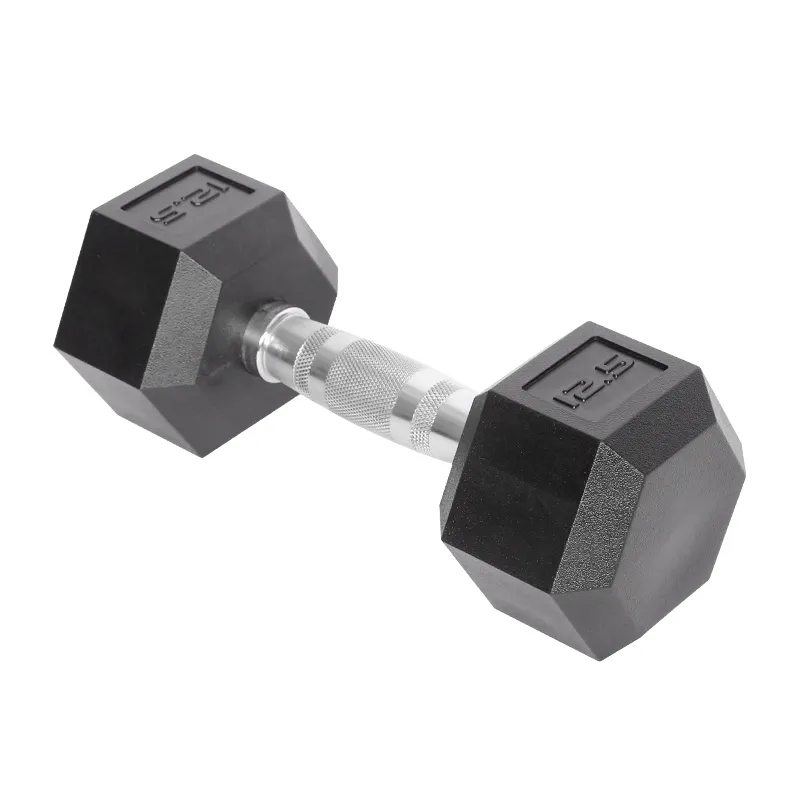Defining CPU vs TPU Dumbbells: Core Material Differences
What Are CPU Dumbbells?
Most CPU dumbbells have cores made from cast iron or steel because they last forever and pack serious weight into compact packages. Serious gym enthusiasts love these weights since they stay put even when doing tough sets where stability matters most. The textured surfaces on these dumbbells help prevent slips during intense sessions, which means safer workouts overall. Manufacturers usually apply a coat of paint not just to make them look nice but also to keep moisture at bay and extend their lifespan. From what many trainers report, these dumbbells can handle years of abuse in commercial gyms without showing signs of wear, so they work great for anyone serious about strength training programs.
What Are TPU Dumbbells?
TPU dumbbells come made from something called thermoplastic polyurethane, which is basically known for being tough yet flexible stuff. Unlike those heavy metal weights, these TPU ones are lighter on the hands and have that nice cushiony feel when lifting. Most gyms stock them in bright reds, blues and yellows too, so they look pretty good sitting around the house compared to boring old iron plates. People who've used them notice how much quieter they are when dropped accidentally, since the material absorbs impacts better than regular metal does. For folks who want their workout gear to work well but still stand out visually, TPU dumbbells hit that sweet spot between useful and stylish.
For more detailed insights into the distinct benefits of each material, you can explore the broader context of "What is the difference between CPU dumbbells and TPU dumbbells?" which delves into their respective applications and performance metrics.
Manufacturing Processes: Casting vs Injection Molding
CPU Production: Liquid Casting Method
Most CPU dumbbells get made using liquid casting, which is basically pouring hot metal into molds. This old school method works so well because it cuts costs and lets manufacturers churn out dumbbells in all sorts of weights and sizes. What makes these dumbbells tough as nails? The casting creates dense metal cores inside, something regular plastic weights just cant match. Fitness centers swear by cast iron dumbbells for their gym floors since they hold up year after year without cracking or breaking down. Sure, the whole casting process takes more time and effort than some alternatives, but folks who actually lift weights know why these cast iron versions command a premium over cheaper TPU options. They simply last longer and feel better in hand during those tough workout sessions.
TPU Production: High-Temperature Injection
TPU dumbbells come out of factories through what's called high temperature injection molding. This process really brings out all the good stuff about TPU material. What makes this method so great? Well, manufacturers can create all sorts of intricate designs and complicated shapes that look pretty nice on display racks. Compared to traditional casting methods, injection molding gives much better results when it comes to getting every dumbbell exactly the same size and shape. Industry insiders know this technique works faster too while creating less scrap material overall. When looking at how the material gets distributed inside during molding, there's real control over everything. That means finished TPU dumbbells have that smooth, consistent look most people want these days. No wonder they've become so popular among fitness enthusiasts who care about both how their equipment performs and what it looks like sitting in their home gym.
Performance Comparison: Durability and Functionality
Lifespan: 8 Years vs 4 Years
Looking at how long different dumbbells last, CPU models tend to hang around much longer than most others, often making it through about 8 years before showing signs of wear. The reason? They're built with really tough materials that can take a beating from daily workouts and still hold up against pretty harsh conditions. Meanwhile, TPU dumbbells don't last nearly as long, usually only about 4 years before they start to break down. For people watching their wallets closely, this difference matters because replacing equipment every few years adds up fast. Most gym owners report that CPU dumbbells keep their weight consistent and don't crack or deform like cheaper alternatives do. So if someone wants something that will stick around for years instead of months, investing in those CPU weights makes a lot more sense in the long run.
Tear Resistance and Hydrolysis Stability
Looking at how resistant materials are to tearing and breaking down when exposed to water helps understand how well dumbbells will hold up over time. CPU dumbbells don't stand up too well against tears because they're made mostly of metal, so they aren't great choices where there's likely to be lots of moisture around. On the other hand, TPU dumbbells really shine when it comes to resisting both tearing and degradation from water exposure. Lab results back this up showing they perform much better than alternatives when humidity levels rise. These dumbbells just keep going without showing signs of wear, no wonder trainers tend to point customers toward TPU options whenever gyms or workout spaces get damp. Anyone who cares about getting good value from their equipment should consider TPU dumbbells since they last significantly longer even under tough environmental conditions.
Grip Comfort and Maintenance
When picking out dumbbells, how comfortable they feel in hand and how much work goes into keeping them in good shape really matters. CPU dumbbells tend to need more TLC because they don't have proper padding around the handles, something many people notice when working out for longer periods. The metal parts get cold too, especially in colder gyms, which makes exercising uncomfortable over time. These weights also demand regular wiping down and protection against rust if kept anywhere damp. On the flip side, TPU dumbbells come with better designed grips that actually fit the hand naturally. Manufacturers often add these soft touch coatings that make lifting sessions more pleasant overall. Plus, wiping off sweat from TPU surfaces takes just seconds compared to the hassle with other types. According to customer feedback across various fitness forums, most folks find themselves reaching for TPU dumbbells again and again simply because they're so much easier on the hands and generally hassle free to keep clean between workouts.
Cost and Environmental Considerations
Price Differences: Premium vs Budget Options
CPU dumbbells tend to sit in the premium price range because they last forever basically. The initial spend is definitely steeper, but most people find they don't need to replace them nearly as often as cheaper alternatives. TPU dumbbells show up all over online ads as budget picks, which makes sense for folks just starting out at home or personal trainers running multiple classes daily. But here's the catch many miss: those TPU weights wear down pretty quickly, so what seems like a good deal now could end up costing more down the road when replacements become necessary every few months instead of years. Looking at customer feedback reveals something interesting too many shoppers overlook completely – people consistently rate TPU based on how little they paid, not really considering how fast these weights actually break down with regular use.
Recyclability: TPUâs Eco-Advantage
When looking at how they affect the environment, TPU dumbbells have something going for them that others don't really match up to. These weights can actually get recycled and turned into something new once they've reached the end of their useful life. That kind of recyclability shows manufacturers care about sustainability stuff, which is exactly what many shoppers are starting to look for these days when buying workout gear. On the flip side, those old school CPU dumbbells made mostly from metal present real problems when it comes time to recycle them. Metals tend to break down over time and often get mixed with other substances during manufacturing processes. A bunch of recent green reports keep pointing out why we need more sustainable materials in our exercise equipment if we want to cut down on all that junk ending up in landfills. So basically, TPU's friendly relationship with the planet isn't just good news for Mother Earth herself, but also taps right into what modern consumers value most nowadays – caring about where things come from and what happens after we're done using them.
Choosing Between CPU and TPU Dumbbells
Commercial Gym Needs: Longevity Over Cost
When commercial gyms shop for dumbbells, they care most about how long the weights will last. Most gym operators go for cast iron plate (CPU) dumbbells since these are known to hold up better over time. The main reason? These weights don't need replacing as often, which saves money in the long run. Looking at what's happening in the market right now shows that gyms are definitely leaning towards heavier duty equipment that stands up to constant use. Fitness professionals know from experience that good quality gear makes all the difference for a successful gym operation. Durable equipment means fewer repairs and replacements, plus members get consistent access without waiting for fixes or new stock.
Home Gym Priorities: Affordability and Sustainability
Home gym owners tend to care more about price than anything else, which is why TPU dumbbells have become so popular despite costing less upfront. They aren't as tough as CPU alternatives, but many green minded consumers still pick them because these weights can actually get recycled when they're done. People generally want gear that works well while also doing some good for the planet. As more folks set up gyms at home, finding products that won't break the bank yet stay kind to the environment matters a lot now. That's pushing sales of TPU dumbbells higher as customers look for ways to work out without harming either their wallets or Mother Earth.
FAQ Section
What is the main difference between CPU and TPU dumbbells?
CPU dumbbells are typically made from metal, offering greater durability and weight, while TPU dumbbells are crafted from thermoplastic polyurethane, providing cushioning and flexibility.
Which dumbbell is better for commercial gyms?
CPU dumbbells are better suited for commercial gyms due to their durability and longer lifespan.
Are TPU dumbbells environmentally friendly?
Yes, TPU dumbbells are recyclable, aligning with sustainability objectives and reducing environmental impact.
Which dumbbell is more budget-friendly?
TPU dumbbells are usually more budget-friendly, offering lower initial costs but may need more frequent replacements than CPU dumbbells.


